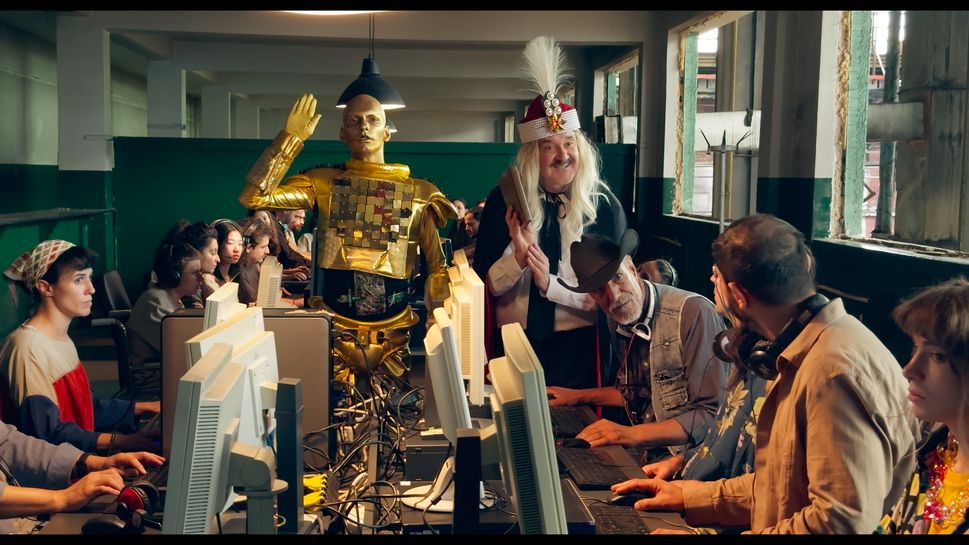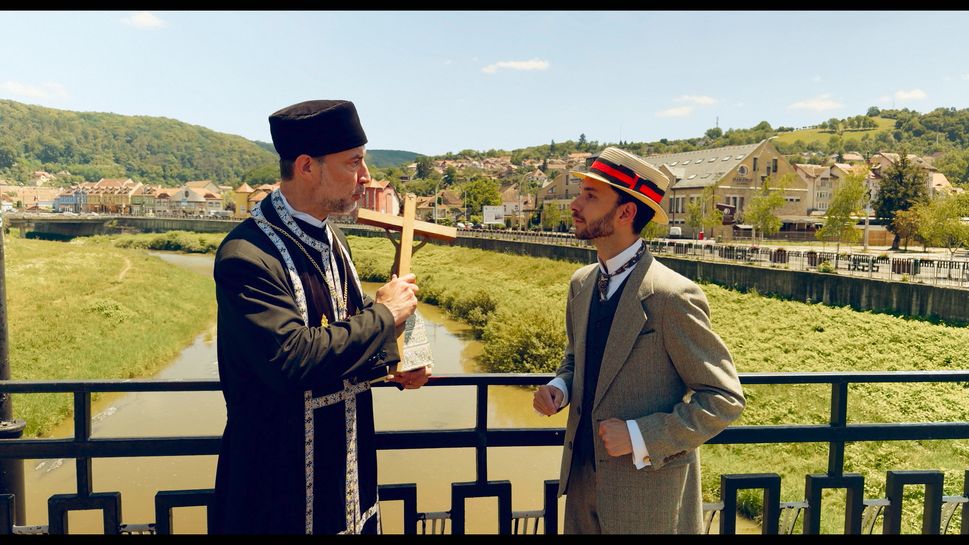‘Dracula’: Radu Jude Explains How His Film Uses AI, Deconstructs the Myth and Pays Homage to Cinema

Dracula is back on the big screen with a vengeance, courtesy of none other than Romanian provocateur Radu Jadu (Kontinental ’25, Bad Luck Banging or Loony Porn, Do Not Expect Too Much From the End of the World). Befitting the iconoclastic filmmaker’s reputation, of course, he is taking you on a bloody wild and absurd, dare we say — insane — cinematic ride to explore the legendary cinema myth in Dracula, world premiering in the competition program of the 78th edition of the Locarno Film Festival in Switzerland on Aug. 10. In the process, he aims to not only dissect Dracula, but cinema itself.
In fact, with the movie made on Dracula’s home turf, namely Transylvania, Jude really sinks his teeth into the most famous vampire and different dimensions of his image, as well as AI. After all, the film shows a young filmmaker working with an AI system to craft various filmic takes on Dracula.
“What happens when a young and curious filmmaker challenges his creativity with the limitless possibilities of a fake AI?” reads a synopsis. “A surprising mix of various stories, from new and old times, about the original myth of Dracula: a vampire hunt, zombies and Dracula crashing a strike, a science-fiction tale about Vlad the Impaler’s return, an adaptation of the first Romanian vampires novella, a tragic romance, a vulgar folktale, AI-generated kitsch stories… and much more!”
Much more indeed. For example, Jude’s Dracula references such big Hollywood names as Charlie Chaplin, Steven Spielberg and Francis Ford Coppola, classic Dracula actor Bela Lugosi, such characters as Frankenstein and Popeye, music stars like Britney Spears, Metallica, Rage Against the Machine and Rammstein, politicians like Donald Trump, Vladimir Putin, Richard Nixon and Joseph Stalin, plus Elon Musk, OnlyFans, TikTok, and many more.
“Our film deconstructs the myth of Dracula through dozens of stories — absurd, pulpy, literary, playful, political, excessive, naughty, fantastic or realistic,” Jude says in a director’s note. “A film about cinema itself.” He has also called it “my humble homage to some great American underrated auteurs: Ed Wood, Andy Warhol and the Fluxus filmmakers.”
But don’t expect a high-end, Hollywood-style look and feel. Jude shot Dracula on an iPhone with the lowest budget possible, as he likes to do.
“Radu Jude resists, stoically, the temptation to make beautiful films,” Locarno artistic director Giona A. Nazzaro recently told THR. “And I mean that as the highest possible praise!”
Check out a clip for Jude’s Dracula here.

I remember last year when you gave a Locarno Pro masterclass, you said that it was time for a Romanian Dracula movie because Hollywood “has done it 1,000 times.” Back then, it was believed that the title of the film would be Dracula Park. How did that change or will there still be a Dracula Park movie, too?
In the end, I shortened the title to make it more general and more precise. I also thought it was a good title and a title that’s already known, recognizable. I think hundreds of films have this title. At the same time, since my film is an homage or a return to cinema, its myths, and this mythology, I wanted the title to be like a real cinema title. I think it is a celebration of forms which may sometimes be outdated, but with new tools. It uses AI images, is shot with an iPhone. It’s in the spirit of Burlesque comedy in a certain way. It’s all these things coming together. So, it’s a film about cinema itself in a certain way.
The film includes mentions of Murder on the Orient Express and big film names, including Chaplin, Spielberg and Coppola, among others. Why did you pick these names?
In each case, there’s a fictional context for this. For instance, one chapter starts with a real story of an actual hospital with rejuvenation treatment in the ’70s. Romanian dictator [Nicolae] Ceaușescu led a lot of influential and rich foreign people to come to this place close to Bucharest secretly, and one of them was Chaplin. When I found this story, I said okay, it’s going to be part of the film.
Actually, becoming young is, of course, a theme of vampire films and of vampirism in general. I’m always thinking of films as being in dialogue with other films or books or paintings or whatever. So this film has a relation with [silent film pioneer Friedrich Wilhelm] Murnau, with Hollywood, with pulp stories and the pulpy aspect of cinema. And it’s interesting that somebody like [French director] Jacques Rivette, who for me is a great role model, says that there is an aspect in cinema which shouldn’t be lost, while at the same time we also need very daring or experimental films. So it has to be a balance, and I am interested in this balance.
I’m interested in pulp and in trash and what is called high culture. And I want to bring them together so that in this film, you can have a lot of pop and pulp stories, but there is also a quote from Wittgenstein at some point. There are idiotic characters, but also someone reciting a poem, and there are a lot of literary references. I think there’s something there about this spirit of telling stories, including vulgar stories. There’s a lot of vulgarity, but also a lot of other stuff.
Vulgarity and sexuality both keep showing up in the movie. How do you use those to provoke viewers or maybe make people think?
I think the Dracula myth is related, in more than one way, to sexuality, so this theme had to appear in the film in one way or another. And then there’s also the spirit of burlesque, combined with the vulgar, which is very avant-garde. Of course, it’s not a film made only for Romania. But the prudishness of Romanian society is still so huge that I take pleasure in challenging it.

Actually, one of the greatest literary geniuses of Romania from the 19th century, untranslatable because of the beauty and use of his language, a man named Ion Creangă, and one of these vulgar stories is adapted by him. Since he’s a treasure of Romanian literature, nobody can accuse me of being vulgar. I will say: “I’m just staging classical literature for all the world to see.”
Dracula also includes quite a lot of references to very modern things, from OnlyFans and TikTok, to such people as Elon Musk and Donald Trump. There’s even a scene that is likely to cause debate where somebody says something along the lines of, “Oh, if I saw Trump, I would shoot him in the head.” How much do you bring politics into this and other films, and why?
We shot the film last year between July and September. In July, when we were shooting, the assassination attempt against Trump happened. So we included that in the dialogue on the spot. This is a lesson from the French New Wave films that I’m very fond of. I consider myself kind of a student of the Nouvelle Vague, especially [Jean-Luc] Godard. The lesson is to let the film be like a sponge that attracts what happens in the world at that moment and captures it. Capturing references, even if they go away after a while, I always find beautiful. I like films to cross over with what happens around.
You also mentioned OnlyFans. Well, that’s that thing, which I don’t know much about. But the actress who plays Vampira, Oana Maria Zaharia, does or used to do a lot of OnlyFans things. So when she told me about that, I said, “Let’s include that from your personal life. We can put that in the film and make your character a mix of what you do in your life with what the character is doing.” I think that made the character richer than I thought initially.
These days, it also seems like politics is everywhere and everything…
I think this is true nowadays. Politics is so much in our daily life, and in a way it becomes such a show that Donald Trump is, which was in an article about Trump being a kind of insult artist, in the tradition of Andy Kaufman. Politics has become a show, a lot of times a bad-taste show. Someone like Trump is always around because of his showman dimension, which, of course, would be great, maybe, if he wasn’t the President of the United States. Now, it just seems like insanely dangerous and insanely stupid.
I want to ask you about AI. You clearly used AI to make parts of Dracula, but you are also commenting on what AI can do and what it is not good at. Talk a little bit about how much you used AI, why and whether you have any ethical concerns.
Well, first of all, I’m interested in all the tools. And I think that comes from my admiration of [Russian filmmaker Sergei] Eisenstein, who was interested in everything and considered everything becoming cinema or montage. I’m interested in everything and all the tools, and I strongly think that we should be able to use everything.

Of course, there are ethical issues, there are environmental issues, there are all kinds of political issues, and so on and so forth. In this case, the concept of me playing with bad AI-generated stories appeared first, and I was not thinking of using AI-generated images at all. But at some point, we were in trouble with the budget. So we were in a situation to either do the film right away or wait two more years to gather the budget. So I said I would find a way. And we found all sorts of possible ways to reduce the budget. I shot on an iPhone and really, really fast. And I replaced extras in some scenes with cardboard cutouts. At some point, I found out that a composer was playing with AI machines. So I visited him, and then said: “Okay, now I can do the movie, because I will transform the expensive scenes by using the worst AI images possible.” That was our idea because I think there’s a point to that.
Now, there, I think, are two ethical issues. One is environmental. People say that using AI is actually ruining the environment because it uses a lot of power, but I’m telling you that the scenes I did with AI, if I shot those in real shooting situations, would be much more expensive and use a much bigger carbon footprint. The other issue is the fact that AI uses a lot of pre-existing things and transforms them. What can I say? I’m against that, but I think the tool is here, like it or not. I think it will be here to stay. So it’s either you use it or not. So I decided to use it and accept the criticism.
And in the end, the film is called Dracula, because Dracula sucks everything. So, the AI and Dracula are the same thing in a certain way. So, for this film, it was a perfect tool. Looking at the whole film, the AI-generated images account for maybe five percent. I think it gives it a certain poetry. I think there’s a new form of poetry in all these bad shapes that AI creates.
You shot Dracula at the same time as Kontinental ’25, and you used some of the same actors for both. Can you talk about that dual filming approach a bit?
Actually, the chronology of the two releases is the reverse filming chronology. First, we prepared and organized ourselves for Dracula, and while preparing the film, I had the idea to add the other film. So, in a way, Dracula is my [Georges] Méliès gesture, and my [Auguste and Louis] Lumière gesture is Kontinental ’25. The idea came to me because I’m interested in the history of cinema, which can offer certain ideas or certain solutions from a production point of view. So when I realized, while testing the iPhone imagery, that I quite liked it, I thought, “Why not make two movies?” So, we prepared them and did the two films back to back. We shot very fast. Kontinental ’25 was shot in 10 days, Dracula in 28.
The actors and the whole crew are identical. I used Serban Pavlu as a priest in one of the films, and I cast him as a priest in the second film, because we had the costume made already. So I think in an economical way, and I’m very much interested in solving my production problems as creatively as possible. There’s creativity in film in the art, but I think there’s also a lot of creativity in production.
Source: Hollywoodreporter
HiCelebNews online magazine publishes interesting content every day in the movies section of the entertainment category. Follow us to read the latest news.
Related Posts
- Janet Nelson Berger, Casting Director on Prestige TV Programs, Dies at 87
- RZA On His New Film ‘One Spoon of Chocolate,’ And His Growth As a Filmmaker: “I Honestly Feel Like I Have Arrived”
- Rupert Grint Returns as Ed Sheeran’s Obsessed Fan in “A Little More” Music Video
- When to Stream ‘Outlander: Blood of My Blood’ Online
- James Lovell, Apollo 13 Moon Mission Leader, Dies at 97





